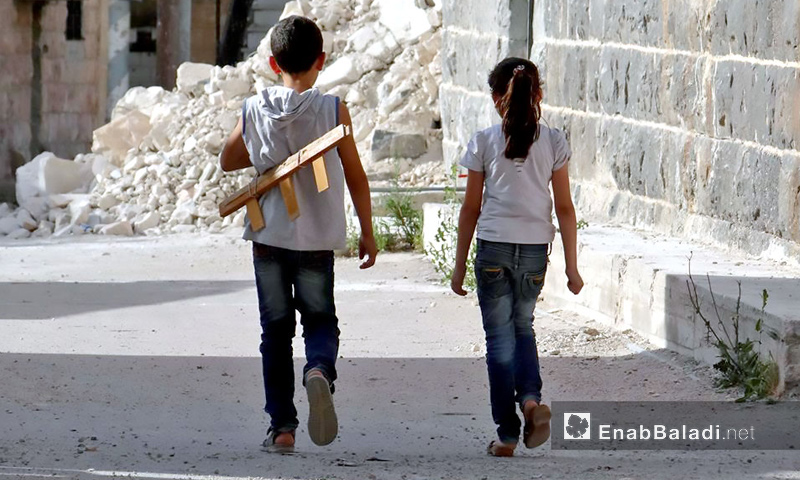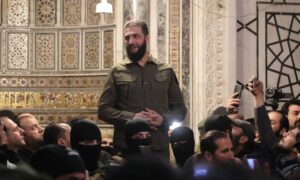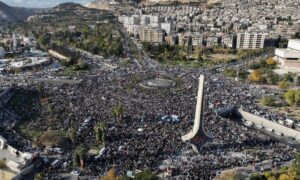Abu Abdou al-Salam who lives in Kafr Zeita in northern Hama brought his son Hussein, 14, to the military headquarters of the local faction announcing his desire to volunteer his child for “Jihad in the name of God” as he was able bodied, tall and broad shouldered.
Enab Baladi documented this case in Hama’s northern countryside in 2014, but the case is no exception. Rather, it is almost the norm that all factions involved in the conflict in Syria operate by regardless of their affiliation or orientation.
Human rights and media organizations have documented local militias loyal to the Syrian regime using child fighters in battles, as the killing of Abdullah Tiseer al-Issa in July 2016 demonstrated. Al-Issa’s killing highlighted, perhaps, the gravest violations of children’s rights by local militias in Syria. It emerged that he was recruited to fight against opposition factions although he had not yet turned 18.
The Lebanese Hezbollah militia is also including child fighters in its fight on the frontline in Syria. Mohammad Hussein Awada, 16, was killed fighting against Syrian opposition factions in what is considered a turning point for the group. Observers see in Hezbollah announcing the boy’s death and disclosing his age at the time as Hezbollah abandoning a condition it had previously maintained that all fighters sent into battle must not be younger than 18.
Although the group has tried to evade the issue, it has provoked much criticism in Lebanon. Social media accounts and websites close to the party such as “SouthLebanon.org” periodically publish obituaries for other minors fighting in Hezbollah’s ranks in Syria.
The same practice exists among Syrian opposition factions, which continuously and publically mourn the death of fighters under the age of 18. The “Islamic State” does not hide that it recruits children into “The Cubs of the Caliphate” in areas under its control. The Cubs have participated in more than one operation in Syria and appeared in video recordings of executions of captives held in “Islamic State” controlled areas.
Some media sources reported the death of tens of Syrian children from the Cubs alongside “Islamic State” forces during recent battles in Mosul. The reports have been confirmed by the Syrian Observatory for Human Rights.
Children caught between psychological preparation and actual participation in battle
Abdallah jokes with his friend in middle school, “Can you take a rifle apart and reassemble it? In Raqqa they taught us that.” A conversation that does not appear normal but appears to be so in these exceptional times.
According to international law, 18 is considered the legal age for recruitment to carry arms. Recruiting anyone under the age of 15 is considered an international violation while recruiting anyone between the ages of 15 and 18 is considered as “recruiting a minor”. Adolescents between the ages of 15 and 18 show the greatest desire to participate in military operations, which makes many commanders agree to include members of this age group within their factions.
There is a difference between those actively participating in battles and military operations on the one hand and mere membership in the faction on the other. Tasks are divided between fighting and administrative tasks, so not all faction members participate in fighting and many have administrative roles within the headquarters.
According to Enab Baladi’s investigation, most factions secretly accept fighters younger than 15, albeit to a limited extent. The investigation met with many obstacles, the most prominent being the refusal of fighters and those commenting on the issue to reveal their full names.
Abdul Rahman, 23 and a fighter in one of the factions, said that one of them refused to enlist his son aged 13 despite the child’s desire to join the faction. They managed to convince the child to return with his father on the basis he could return to fight once he turns 15. Abdul Rahman confirmed that many of the fighters on the front lines are between 15 and 19.
Children’s presence in the ranks is, in many cases, due to their own desire to fight. While many parents oppose this and try to prevent them from joining, other parents prefer their children to fight so that they will learn to use a weapon and become strong rather than remaining in the streets without anything useful to do.
Their stance is strengthened by the atmosphere of general approval of child recruitment, the lack of political consciousness of the need to find a solution and a sense of helplessness that motivates some to believe that the only thing that will swing the conflict in the opposition’s favor is to increase the number of opposition fighters.
Samir, 21 and a fighter in a brigade of 20 fighters, said that five of the fighters in his brigade have not yet turned 18. One of the fighters is 15 and works as a Dushka sniper, another works as a BKC loader and a third, aged 16, as an attacker. He added, “All the members are accepted in the brigade if they can handle their weapons.”
Under International Humanitarian Law and in accordance with the treaties and conventions, the recruitment and exploitation of children under 15 to work as soldiers, is forbidden. The international Criminal Court defines this as a war crime.
The Human Rights Act stipulates that 18 is the legal minimum age for recruitment and exploitation of children in hostilities.
Conflict parties using and recruiting kids would be added to the List of Shame which is published annually by the Secretary General of the United Nations.The “Optional Protocol on the Involvement of Children in Armed Conflict” raised the minimum age for compulsory recruitment into the armed conflict to 18 years old, and Syria is part of this Protocol.
Ideas about fighting and warfare tend to appear more strongly among children during adolescence. This is particularly prominent where adolescents are influenced by fathers, older brothers or friends engaged in conflict, as we see in the current circumstances. Although their membership in opposition factions remains voluntary, commanders accept them joining, considering it a “necessity” in the “fight for survival.”
Abu Talha, a Sharia judge in one of the factions, said that he refused to accept any children under the age of 18, but from time to time explains to children of different ages the reality they are living in and the reasons for fighting. He explains to them that it is “Jihad to fight enemies” and not “Jihad for conquest”. He said, “Many of the fighters did not join the conflict based on religious motives but were motivated by injustice. The faction members are from the area they fight in.”
Abu Mohammad, a teacher in a private school, who has students in his classes who lost their fathers in the conflict, explained that, “Some of them seek revenge”. Abu Mohammad, however, repeatedly reminds them that, “Jihad is with science and not weapons”.
The Ahrar al-Sham Islamist movement issued a video in September of a group of youth who participated in battles against the Assad forces in Aleppo’s southern rural region. The video showed Tarek Abu Ziad, the group leader, who appeared to be under the age of 18. Enab Baladi’s investigative team subsequently discovered that Abu Ziad is under 17 and began volunteering in the movement relatively recently before becoming a group leader. He recently left the movement to join the Suqur al-Sham brigade.
Enab Baladi directed a question to the resources and membership division of Ahrar al-Sham movement about the child recruitment phenomenon. Rida al-Homsi, the division administrator, explained that one of the most important conditions for membership is age, as the Ahrar al-Sham movement does not accept anyone under the age of 17. The movement also considers the physical attributes of applicants, so if the applicant is weak physically despite being over the age of 17, he will not be accepted.
Child recruitment: an undeniable phenomenon in the Jazira area
In the “autonomous administration” areas, the Democratic Union Party has faced local criticism regarding child recruitment. One case involved the kidnapping of Lava Anwar Hana, 14, from in front of her house in the village of Maaretin in the Afrin area north of Aleppo in January 2016. It later emerged that she was taken to one of the Kurdish People Protection Units training centers.
Activists in the areas of Jazira, Kobani and Afrin, which are under the control of the “autonomous administration”, recount many stories similar to Lava’s, although the law on the “duty of self-defense” issued at the beginning of 2016 set the legal age for recruitment between 18 and 30 years old and specified that it applies to males only.
Enab Baladi spoke to Abdul Karim Sako, a member of the legislative council office in the Jazira province, who explained that recruiting children and their participation in armed conflict is not a new phenomenon, but is deeply connected to cultures and social awareness.
Sako said, “I consider the phenomenon of child recruitment a violation of international conventions. We we should encourage children to learn and gain knowledge and skills for them to be a generation that will lead their society and people. It is more beneficial that they gain their share of knowledge and science in addition to practicing the hobbies they like.”
Regarding the recruitment of children in areas under “autonomous administration”, also called Rojava (Western Kurdistan), especially in the People’s Protection Units and the Women’s Protection Units, Sako said, “We cannot deny the phenomenon in Rojava. It is like any of the areas in Syria and the rest of the world – there are such cases but I can confirm that they are very few in comparison with the media coverage which exaggerates it. The authorities have always avoided including minors in military operations regardless of the causes.”
Sako highlighted that the “autonomous administration” had found it necessary to reintegrate minors who were previously recruited back into society and work and rehabilitate them. The “autonomous administration” worked to obtain their immediate release in coordination with human rights and humanitarian organizations. He added, “I can say that today there are no minors among the fighters, but there are some children in the streets of our cities who wear the People’s Protection Unit uniforms… I do not know if some people think that these are members of the Units.”
Sako’s words, however, do not tally with a report released by Human Rights Watch in July 2015 entitled, “Kurdish Forces Violate Ban on Recruiting Children”, which stated that in June 2014 the People’s Protection Units signed “a commitment accord” with Geneva Call, a non-governmental organization. Based on the accord, the Units pledged to release all fighters under the age of 18 within one month. A month later, they released 149 children.
Despite the pledge it made and some progress during the year following the accord, Human Rights Watch documented that children under the age of 18 joined the Units’ ranks and some children were killed in fighting in 2015.
Human Rights Watch confirmed that 10 children among the 59 mentioned in their report joined the People’s Protection Unit and the Women’s Protection Unit in the past year although they are under the age of 15.
In turn, Amin Hussam, a member of the General Secretariat of the Kurdish National Council, confirmed that many “radical” organizations recruit children who are barely 14 into their mandatory training camps. Hussam warned that this will create an atmosphere of instability and cause an entire generation to lose their future. He called on the United Nations to monitor these organizations and put in place appropriate mechanisms to ensure this.
Child recruitment into armed groups is a phenomenon that is difficult to curtail or end as long as the war continues, fuelled by the revolutionary, religious, ethnic and material discourse of all the actors participating in the conflict in Syria.
if you think the article contain wrong information or you have additional details Send Correction
النسخة العربية من المقال
-
Follow us :


















 A
A
A
A
A
A








 More In-Depth
More In-Depth